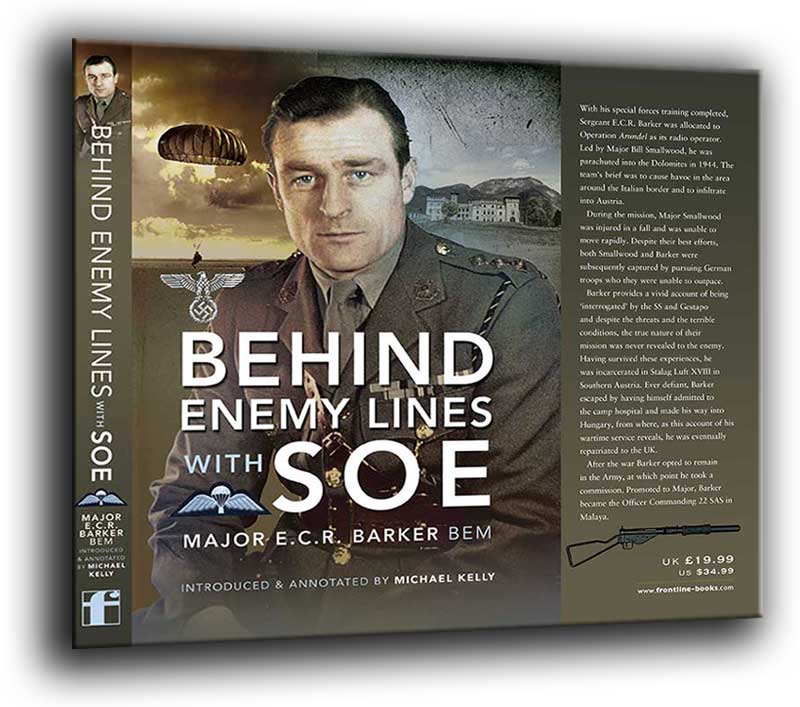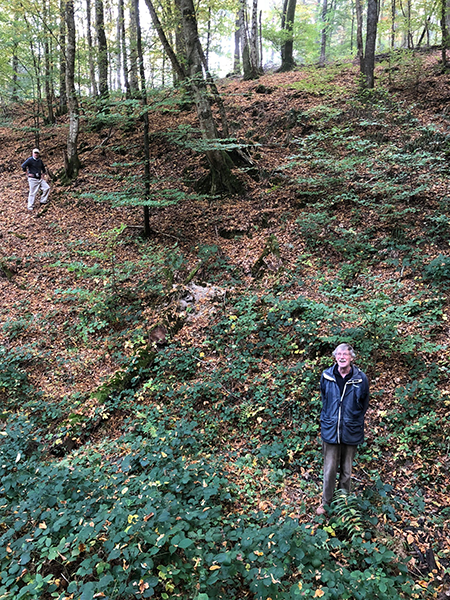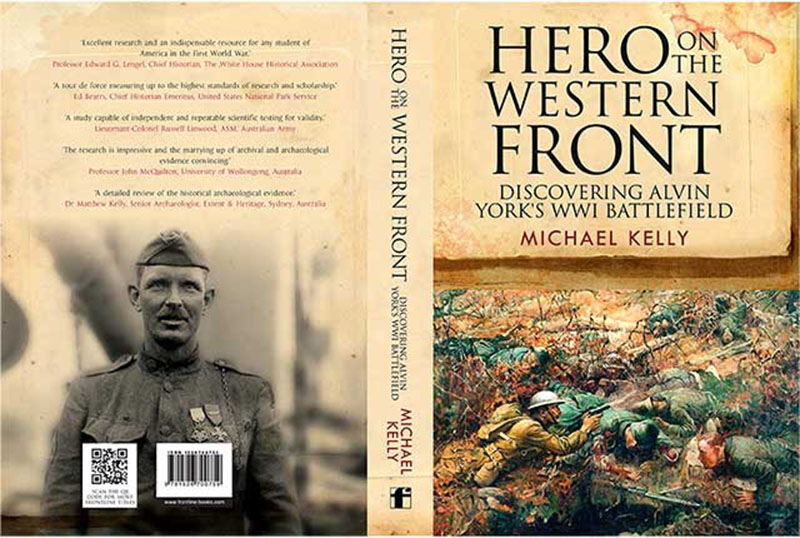BEHIND ENEMY LINES WITH SOE
By Major Barker BEM
Introduced & Annotated by Michael Kelly

“Available now. RRP £25 but for a limited period signed copies are available at £22 plus postage & packing. Please find your country postage rates from the click on selection box below.”
Book review by Nigel West “A fascinating account of Charles Barker’s adventures with SOE and his participation in the CLOWDER mission. At last, a brave officer on a clandestine assignment in the Balkans receives the recognition he deserves.”
|
Binding : Hardback ISBN : 9781526779748 Pages : 256 Dimensions : 9.25 X 6 inches Published March 31st 2021 By Major Ernest Barker BEM & Michael Kelly |
This is your only online opportunity to purchase a copy signed by the author. |
With his special forces training completed, Sergeant Barker BEM was allocated to Operation Arundel, a part of the Clowder Mission, as its radio operator. Led by Captain Martin-Smith MC, he was parachuted into the Dolomites in 1944. The team’s brief was to liaise with the Garabildini partisans and open lines into Austria whereby resistance to the Nazi’s could be nurtured. Barker describes eloquently the beautiful scenery in the Friuli region, now an area of peace and tranquillity, but in 1944 there were many dangers from the SS, Gestapo, and members of opposing partisan groups.
During the mission, he was allocated to work with Major Smallwood, and whilst traversing the mountainous regions of the Dolomites, Bill Smallwood was injured in a fall and was unable to move rapidly. Despite their best efforts, both Smallwood and Barker were subsequently captured by pursuing German troops who they were unable to outpace.
Barker provides a vivid account of being ‘interrogated’ by the SS and Gestapo and despite the threats and the terrible conditions, the true nature of their mission was never revealed to the enemy. He survived these experiences; and was incarcerated in Stalag Luft XVIII in Southern Austria. Ever defiant, Barker escaped by having himself admitted to the camp hospital and made his way into Hungary, from where, as this account of his wartime service reveals, he was eventually repatriated to the UK.
After the war Barker opted to remain in the Army, at which point he took a commission. Promoted to Major, Barker became the Officer Commanding 22 SAS in Malaya. He was killed in a helicopter crash in Malaya in 1953, before he could see through his plan to have his memoir published.
Major Barker was never able to publish his paper and it would be 75 years before it saw the light of day and his story could be heard.
Signed copies of this book will be available only on this website. Price: £25.00 + P&P
 |
 |
| Picture taken October 2018 | Note George Pattullo, the shadowy figure in the left background. |
‘Hero On The Western Front’ Discovering Alvin York’s Battlefield. Published 2018
Locating The Sgt. York Medal Of Honour Action - The Edwin C. Bearss Opinion
Edwin C. Bearss - Chief Historian, Emeritus National Park Service and U.S. Marine
This is a book written by British historian Michael Kelly about the discovery of the site where Corporal Alvin C. York of the 82nd U.S Division killed twenty-one of the enemy and took 132 prisoner in October, 1918.
Hero on the Western Front Discovering Alvin York’s WWI Battlefield
Michael Kelly
|
Hardback. ISBN: 9781526700759. 360 pages 200 color & black and white illustrations. Published in 2018. Frontline Publications |
Click here for Author's Video Introduction.
Early in the morning of October 8, 1918 in the dying weeks of World War I, the American Expeditionary Force together with the French army were pushing north in the Meuse-Argonne area of France. The offensive had started on 26 September and just two weeks later the 82nd Division was on the north-western edge of the village of Chátel-Chéhéry. The 2nd Battalion, 328th Infantry, 82nd (All American) Division had been ordered to push forward and secure the Decauville Railway and by so doing, inhibiting German supply and helping to relieve the ‘Lost Battalion,’ elements of the 77th Division who were cut off at Charlevaux mill, some eight kilometres to the west.
The 328th were held up by scything enemy machine gun fire and it was decided a seventeen-man patrol should be designated to work their way to the rear and take the enemy guns. Alvin C. York from Pall Mall, Tennessee was a corporal and section leader in this squad. After working their way forward, evading enemy fire, they surprised a large group of Germans having breakfast by the side of a stream.
Moving in to take them prisoner, the American patrol were fired upon and six were killed, and others seriously wounded, including Acting Sergeant Bernard Early the patrol leader. York returned effective fire and at the end of the fire-fight 21 Germans lay dead, the remainder surrendered. York rounded them up, and with the remnants of the American patrol, marched them back to the American lines collecting more prisoners on the way. He reported with 132 prisoners. He was told by an officer, “Well, York you must have captured the whole damned German Army.”
For his actions that day York was awarded the Congressional Medal of Honor and promoted to Sergeant.
Over many years there have been attempts to locate the site of York’s fight, none of which have proved successful. This book is about a group of professionals led by Doctor Tom Nolan, who at that time was the director of the Laboratory for Spatial Technology, Department of Geo-sciences at Middle Tennessee State University. Over a period of five years, under his leadership and the expertise of team members, notably Brad Posey, the Nolan Group endeavoured to locate the York site using military records, both American and German and American Graves Registration detail.
The book describes the action on that day. It gives the accounts of the American soldiers and of the German units that were in action that day. In a shining example of team cooperation, the book describes the archaeological expertise employed and the resultant artefact findings by the Nolan Group. Each artefact was logged meticulously using Geographical Information Technology and at the end of the field work, a comprehensive picture was illustrated which corroborates the historical records. One example of the meticulous methodology adopted by the Nolan Group, is the location map annotated by Dr. Nolan and which is produced on this website (click here to view the map). The book will lead the reader to conclude that the fight took place exactly where the Nolan Group say it happened.
It is interesting to note that the ravine where the Nolan Group say the fight happened was subject of fighting only on that one-day, 8 October 1918 meaning the artefacts cannot be associated with any other engagement.
To view our Press Release click here.
Watch the book being discussed on C-Span here.
To view our Dear Friends 21/01/21 Letter click here.

Reviews:
This remarkable forensic detective story is a rare find; it is the complete book; it already holds pride of place in my history library. It is an excellent 'package'. A beautifully written story, together with detailed plans, diagrams and photographs reflect Michael Kelly's impeccable research. The package of which I speak is completed by the masterly document design, excellent printing and binding, the choice of font and the smoothly flowing and logical writing (and a very reasonable price!). Do a friend or relative a favour; consider buying it for them as a Christmas gift, especially if the recipient enjoys military history, detective stories, and a focus on the tragedy that was the First World War.
Colin Fiford, Victoria, Australia
I highly recommend Michael Kelly's book, which I have eagerly awaited since pre-ordering back in March. It has exceeded my expectations. I have been to the York battlefield three times and am familiar with the professional disagreement regarding the precise location of the legendary shootout. I'm a student of the arguments on each side. Before this book, one side of the argument had seemingly prevailed and the matter appeared settled. Read the full review on Amazon.

A Soldier From the Grimsby ‘Chums’ - WW1
Details of our cookie policy may be found here.
To view our GDPR Consent Form click here.
To view our GDPR Policy Statement click here.

